Soup was one of my favorite meals in New Zealand. My mother often made chicken and rice soup with the stock water of a boiled chicken, adding egg-and-lemon sauce to it, along with some rice, salt and pepper. To make it more savoury, she would add a sachet of Maggi chicken-noodle soup. The colder climate - Wellington was often wet and windy - made soup a necessity, with the added advantage that it was a simple meal to prepare, especially for a woman who ran a shop every day of the week (the chicken was saved for another meal, usually a roast). Another favorite soup of my father's was tomato soup made from a Maggi sachet, made in a similar way to chicken soup (without the egg and lemon). At university, some health-conscious classmates of mine drank hot soup made with Cup-a-soup instant mixes and hot water boiled in a ZIP heater.
Soup is what gave us the word 'restaurant': "The modern restaurant industry is said to be based on soup. Restoratifs (wheron the word "restaurant" comes) were the first items served in public restaurants in 18th century Paris." Restoratifs - restaurers - were a kind of soup.
Although we have Greek fish soup every now and then during the winter, I cannot say that the Cretan soups I was introduced to when I first came to the island made any lasting impression on me, except to loathe them even more than I did when I first started having them. As I recall (and eventually learnt to make myself), fish soup was made with fish, carrots, potatoes, courgettes, celery, onions, some tomato and rice, and the only difference between meat soup and fish soup was that chunks of beef were used instead of fish. I was probably discouraged by the similarity of the ingredients, and the whole idea of eating in essence the same recipe put me off making these soups. To top it all off, the fish was smelly, and the beef was tough (as Greek beef usually is), not a good combination to interest children in eating this kind of meal. I still prefer to eat the fish and vegetables a a raw salad rather than the psarosoupa made out from the stock.
My present soup-making exploits reflect my own tastes in soup, which are closer to other European cuisines. I have always loved thick and chunky minestrone-type soups, where all the ingredients are added to the soup in small visible pieces. If you like onion, leeks and garlic as much as I do, then a good French onion soup can't be beat. Finally, there's the creamy type of soup (like leek and potato potage) made with whatever is lurking in your fridge or freezer, boiled down to a pulp and heated before being served. These soups are mainly vegetarian, but the best versions of all these soups, in my humble opinion, are made with a meat-based stock.
Recipes for good stock abound on the internet. My only problem with those recipes is that they make large quantities of stock which then needs to be frozen and re-used. This is all very well, but my deep freeze is usually well stocked, and cannot handle liquid containers whose contents still need to be cooked into a meal. Freezing bits and pieces of vegetables to make them into stock also seems pointless, since vegetables can be found everywhere you look in Crete. Therefore, it is a waste of space and energy to freeze this sort of thing in a Cretan kitchen. I have my own way to make good stock, largely based on the kind of meat cuts we buy in Crete.
We don't buy meat often for our household, so we don't eat a lot of meat in general. But meat is an integral part of the weekly diet, and it is always eaten at the weekend. When we make our meat purchases, it is nearly always from our local butcher, who is often supplied by local farmers. The kind of chicken we buy is free-range, fed on corn, grass and vegetable peelings. To buy this kind of chicken (I always ask for it to be chopped into smaller pieces), you need to ask for 'horiatiko', similar to the word used to mean 'Greek salad', meaning 'village-style'. It contains large deposits of fat. This is exactly why I buy it - one small piece of this (with the skin) will make enough soup for six hungry people.
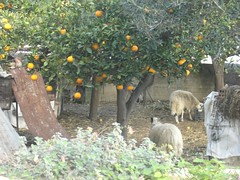
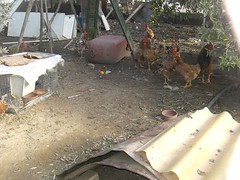
Animals reared free range; scenes from my uncles' farm: sheep in a pen surrounded by orange trees and diktamo bushes, hens in a coop,
Picking out ready-to-discard vegetables (all the vegetables in the fridge that you just know will go to the bin if you don't use them soon) and adding just one small piece of fatty meat has now become my favorite soup-making technique; there is always one main ingredient (to give the soup a name), but everything else depends entirely on whatever is at hand. Everything is allowed to boil away to make a rich creamy soup. These kinds of recipes remind me of one of my favorite anecdotal folk tales: one-nail soup (or stone soup, in some cultures).
The last time I made pumpkin soup pumpkin soup, this is what I added to the basic recipe:
1 lonely leek, all parts, roughly chopped, including green part
2 tomatos, at the onset stage of attack from garden pests, from my early December harvest
the scraggly neckbone of a chicken - very tasty, but too bony to be enjoyed properly
5-6 rocket leaves that had lost their crispiness and would not have been eaten raw
One of my favorite winter vegetables is the humble leek. Leeks are not often used in Cretan cooking. Wild leeks do grow in Crete, and are often mixed into wild greens (and sold as a mixture in this way), but they are never sold on their own. The local supermarket chain in Hania sells imported leeks from Holland, a country that has few good land resources, meaning that most of its exported fresh produce is most likely grown hydroponically using soilless culture. An Athenian-based supermarket chain that operates in Hania sells locally grown leeks; why it wasn't the other way around doesn't surprise me, as leeks are nota commonly found ingredient in Cretan food. Leeks are bought mainly by foreigners (like myself!) and tourist residents, whereas locals will only buy one or two leeks, maybe to add as a flavouring to a meal.
During a visit to the supermarket, I was lucky to bump into another woman also buying leeks. While we were waiting for our produce to be weighed, I noticed that she knew where to look on the assistant's worktop to find a knife. She cut off the dark green parts of the leeks, the parts of the vegetable that recipes always tell you to discard, like the tough outer leaves of a cabbage. Just when I thought she was going to throw them away (and hence not throw away her good money in the weighing process), I noticed her putting them back into the plastic bag. I asked her what she intended to do with them. "Soup," she said, adding that this part of the leek is not as tough as people make out; it simply needs a long boiling time to soften it, enhancing the flavour of the soup stock.
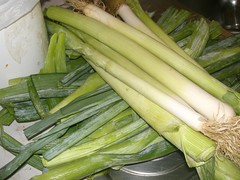
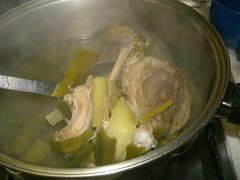
Locally grown leeks are more slender than the hydroponic Dutch imports; they resemble very tall spring onions. The meat from the sole lamb chop that was used for the stock was minced into the soup for a richer stock flavour, as it contained no fat to make a thick stock.
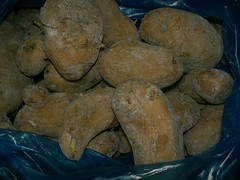
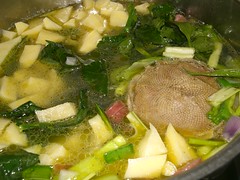
My uncles gave me some potatoes in June when they harvested them from their field. About a month ago, they asked me if I wanted some more; I wasn't prepared for these straggly looking tubers. They told me that, despite their age, these potatos taste better than new potatos which may be harvested when they are too green to be eaten; the white dust is chalky lime, used to keep away insects. It doesn't affect the taste of the peeled potato.
In my latest leek and potato soup, I let an escaped lean lambchop (found lurking in the freezer drawer) and a thin spicy sausage boil away in a large pot of water with about 5 whole leeks, roughly chopped, 2 unattractive old potatos, peeled and cubed, and one large artichoke, frozen since the end of last spring, now too brown to be visually appealing.
Winter has finally arrived in Hania. A few nights ago, after the freezing cold temperatures - we finally turned on the heating - I heard a a shower of rain falling in the early hours. It woke me up and my mind went to the washing I had hung out to dry. In the morning, I saw an uplifting sight - snow, SNOW on our mountains, LEFKA ORI! The overnight rain acted like an automatic sprinkler system, with very little interruption to our life (apart from my wet laundry), watering my spinach and carrots and radishes, so I expect a good bounty. The snow on Lefka Ori means that, despite the likely lack of tourists next year, there'll be plenty of water for us to keep ourselves clean, drink, water our gardens, wash our horta, and keep our sewers clean.
And in this cold weather, coupled with the serious unrest my country finds itself in, these soups make the best meal imaginable, along with a loaf of home-baked bread, like the one Aris told me to make. Such meals are made for sharing, so as Phivos rightly points out, κοπιάστε! (kopiaste!) You're all welcome!
©All Rights Reserved/Organically cooked. No part of this blog may be reproduced and/or copied by any means without prior consent from Maria Verivaki.


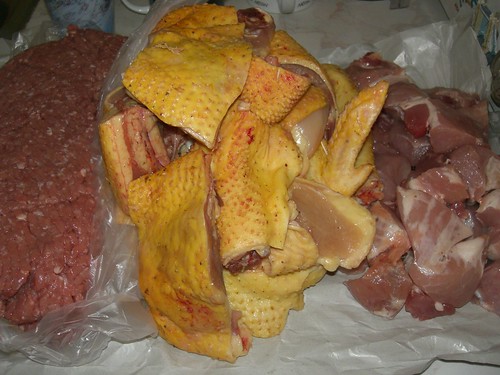
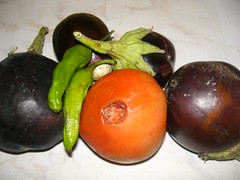
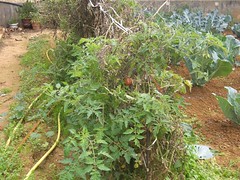
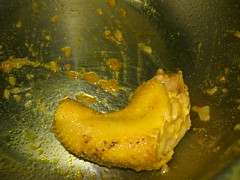
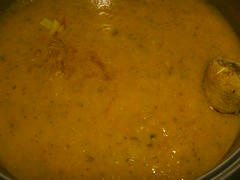

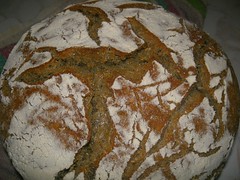
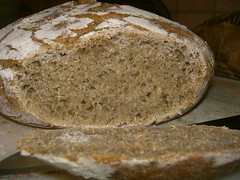
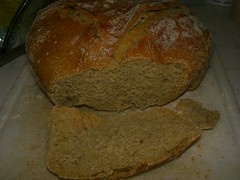
These soups would be very comforting Maria for many reasons. We need them all the more here in Western Canada with temperatures hovering around minus 18 celsius...brrrrrr!!!!I better put on a sweater it makes me cold just thinking about it!
ReplyDeleteOh, Maria... I'm going to write an exam in less than 12 hours, and now all I want is a nice pot of soup! I wonder if I could convince my husband to get cooking???
ReplyDelete(P.S. I'm so angry about what is happening in Greece right now. I've read your posts in interest, and have refrained from replying because I think my ranting would end up being longer than your post!)
WOW! What a loaf that is!
ReplyDeleteLeeks make soups sublime and that loaf...yes, that's Psomi!
ReplyDeleteSoups are the only thing I tend to enjoy in colder months. And like you, I enjoy using leeks for their flavour...beautifully written and explained yet again Maria!
ReplyDeleteΜαρία μου, όλα αυτά τα υλικά για μια σούπα; Πάντως να ξέρεις τρελλένομαι για σούπες!
ReplyDeleteI wish I found find fatty bits of yellow chicken like that in the UK. Looking at them, they just scream flavour!
ReplyDeleteYour bread looks great - let me know if you ever try a sourdough version using that technique!
I agree about leeks - they are much sweeter than your standard spanish onion which is so prevalent here - I use them in lieu of onions more and more.
"Stone Soup," I hadn't thought about that story in ages! Maria, are you baking bread now? It is wonderful to see a photo of snow upon the Lefka Ori.
ReplyDeleteMaria,
ReplyDeleteNot too many places in the world where we could obtain and eat food like yours! And the bread!! I also eat the whole leek (even the roots if they are not shriveled!).
By the way: many times when I make stock I reduce it, taking a whole pot into what fills two ice cube trays. It's much more concentrated, and takes up less space, and since each cube is about 1 cup worth of stock, it comes in pretty handy. This way I don't ever have those sodium-packed "bouillon cubes" like Oxo in my pantry. Just a thought in case you're ever tempted.
ReplyDeleteI couldn't convince my husband to make me soup (instead he made a delicious pasta with ground meat and mushrooms), and even though I ate his meal and enjoyed it very much, ever since reading this post I've been craving soup!
I am not a soup lover, but every once in a while during winter months, I crave a nice hot soup. Never liked fish soup though. The leek and potato soup looks great. The bread too!
ReplyDeleteI hope the unrest in Greece will come to an end soon.
SOUP! My favorite food group! That is such great info that you got from the lady buying leeks! I, too, thought she was going to discard the green tops. I don't use leeks very often, but I do like them. I love the looks of that chicken with the yellow skin. Everything here looks fantastic ... pumpkin soup, leek and potato soup with the escaped lamb!, and that wonderful bread. YUM!
ReplyDeleteloved the photo with the sheep under the orange tree!I can almost smell...:)
ReplyDeleteHmmm... This is actually the first time I hear that people discard the green parts of leeks! I've been eating them all my life and in fact, I like them more than the white parts. :)
ReplyDelete